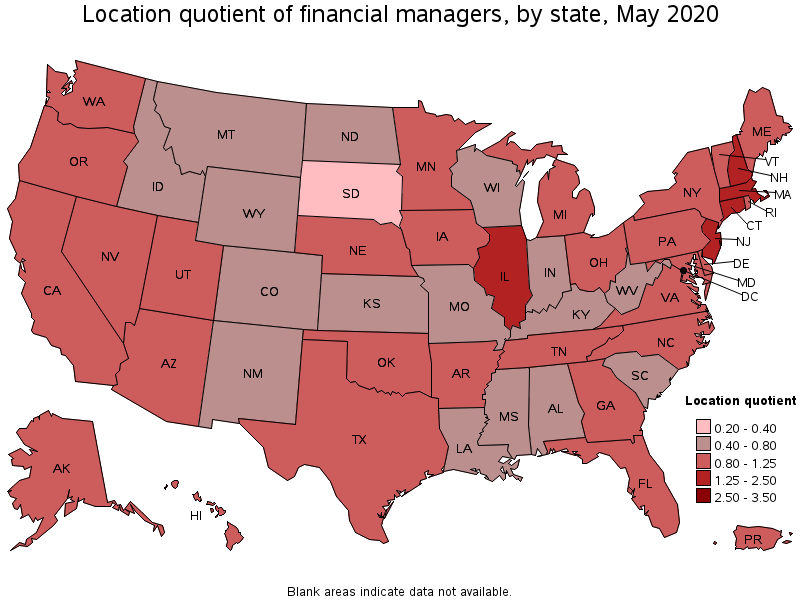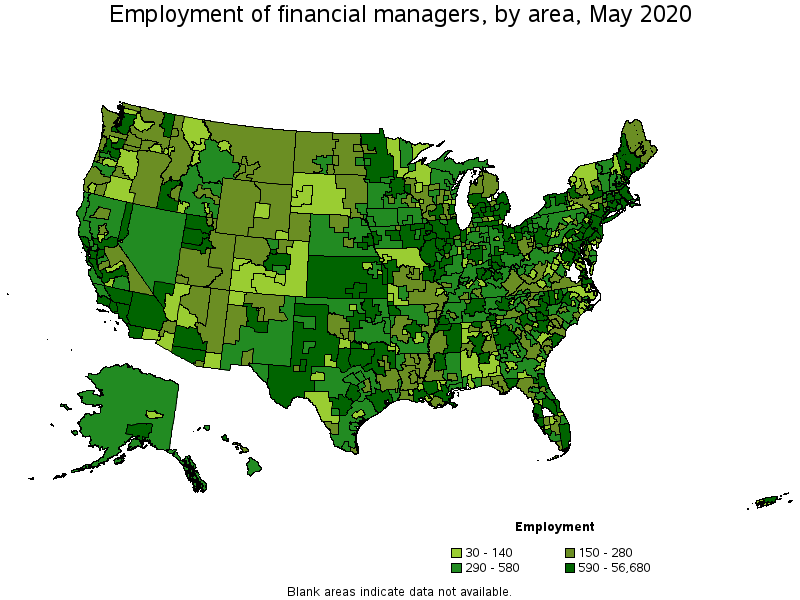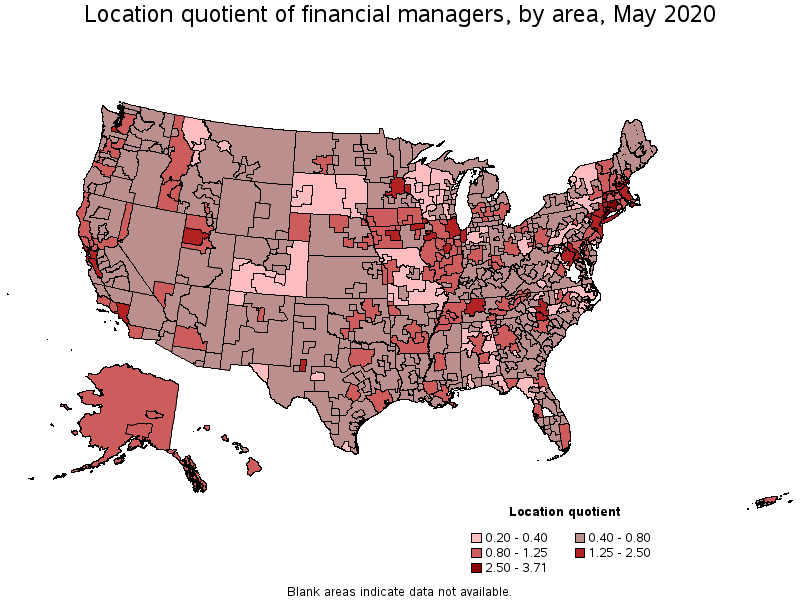An official website of the United States government
 United States Department of Labor
United States Department of Labor
Plan, direct, or coordinate accounting, investing, banking, insurance, securities, and other financial activities of a branch, office, or department of an establishment. Excludes "Financial Risk Specialists" (13-2054).
Employment estimate and mean wage estimates for Financial Managers:
| Employment (1) | Employment RSE (3) |
Mean hourly wage |
Mean annual wage (2) |
Wage RSE (3) |
|---|---|---|---|---|
| 653,080 | 0.5 % | $ 72.84 | $ 151,510 | 0.3 % |
Percentile wage estimates for Financial Managers:
| Percentile | 10% | 25% | 50% (Median) |
75% | 90% |
|---|---|---|---|---|---|
| Hourly Wage | $ 34.05 | $ 46.04 | $ 64.51 | $ 89.44 | (5) |
| Annual Wage (2) | $ 70,830 | $ 95,770 | $ 134,180 | $ 186,030 | (5) |
Industries with the highest published employment and wages for Financial Managers are provided. For a list of all industries with employment in Financial Managers, see the Create Customized Tables function.
Industries with the highest levels of employment in Financial Managers:
| Industry | Employment (1) | Percent of industry employment | Hourly mean wage | Annual mean wage (2) |
|---|---|---|---|---|
| Credit Intermediation and Related Activities (5221 and 5223 only) | 98,570 | 4.86 | $ 59.64 | $ 124,040 |
| Management of Companies and Enterprises | 74,260 | 3.07 | $ 79.56 | $ 165,480 |
| Accounting, Tax Preparation, Bookkeeping, and Payroll Services | 42,750 | 4.36 | $ 84.23 | $ 175,200 |
| Securities, Commodity Contracts, and Other Financial Investments and Related Activities | 41,920 | 4.45 | $ 99.06 | $ 206,050 |
| Insurance Carriers | 26,990 | 2.24 | $ 82.14 | $ 170,850 |
Industries with the highest concentration of employment in Financial Managers:
| Industry | Employment (1) | Percent of industry employment | Hourly mean wage | Annual mean wage (2) |
|---|---|---|---|---|
| Other Investment Pools and Funds | 680 | 6.32 | $ 82.55 | $ 171,710 |
| Credit Intermediation and Related Activities (5221 and 5223 only) | 98,570 | 4.86 | $ 59.64 | $ 124,040 |
| Securities, Commodity Contracts, and Other Financial Investments and Related Activities | 41,920 | 4.45 | $ 99.06 | $ 206,050 |
| Accounting, Tax Preparation, Bookkeeping, and Payroll Services | 42,750 | 4.36 | $ 84.23 | $ 175,200 |
| Insurance and Employee Benefit Funds | 270 | 3.93 | $ 73.64 | $ 153,170 |
Top paying industries for Financial Managers:
| Industry | Employment (1) | Percent of industry employment | Hourly mean wage | Annual mean wage (2) |
|---|---|---|---|---|
| Securities, Commodity Contracts, and Other Financial Investments and Related Activities | 41,920 | 4.45 | $ 99.06 | $ 206,050 |
| Other Information Services | 3,130 | 0.90 | $ 98.27 | $ 204,410 |
| Monetary Authorities-Central Bank | 630 | 3.21 | $ 96.53 | $ 200,780 |
| Cable and Other Subscription Programming | 310 | 0.61 | $ 94.48 | $ 196,520 |
| Computer and Peripheral Equipment Manufacturing | 990 | 0.62 | $ 93.91 | $ 195,340 |
States and areas with the highest published employment, location quotients, and wages for Financial Managers are provided. For a list of all areas with employment in Financial Managers, see the Create Customized Tables function.

States with the highest employment level in Financial Managers:
| State | Employment (1) | Employment per thousand jobs | Location quotient (9) | Hourly mean wage | Annual mean wage (2) |
|---|---|---|---|---|---|
| California | 92,670 | 5.64 | 1.20 | $ 78.20 | $ 162,650 |
| Texas | 46,340 | 3.83 | 0.82 | $ 71.57 | $ 148,860 |
| New York | 45,390 | 5.22 | 1.11 | $ 103.67 | $ 215,640 |
| Illinois | 41,460 | 7.37 | 1.57 | $ 71.45 | $ 148,620 |
| Massachusetts | 33,320 | 9.95 | 2.12 | $ 76.44 | $ 158,990 |

States with the highest concentration of jobs and location quotients in Financial Managers:
| State | Employment (1) | Employment per thousand jobs | Location quotient (9) | Hourly mean wage | Annual mean wage (2) |
|---|---|---|---|---|---|
| Connecticut | 17,700 | 11.49 | 2.45 | $ 81.97 | $ 170,500 |
| District of Columbia | 7,060 | 10.27 | 2.19 | $ 85.54 | $ 177,920 |
| Massachusetts | 33,320 | 9.95 | 2.12 | $ 76.44 | $ 158,990 |
| Illinois | 41,460 | 7.37 | 1.57 | $ 71.45 | $ 148,620 |
| New Hampshire | 3,920 | 6.33 | 1.35 | $ 63.67 | $ 132,420 |

Top paying states for Financial Managers:
| State | Employment (1) | Employment per thousand jobs | Location quotient (9) | Hourly mean wage | Annual mean wage (2) |
|---|---|---|---|---|---|
| New York | 45,390 | 5.22 | 1.11 | $ 103.67 | $ 215,640 |
| New Jersey | 22,900 | 6.05 | 1.29 | $ 88.52 | $ 184,130 |
| District of Columbia | 7,060 | 10.27 | 2.19 | $ 85.54 | $ 177,920 |
| Delaware | 2,310 | 5.42 | 1.16 | $ 84.92 | $ 176,630 |
| Colorado | 7,450 | 2.89 | 0.62 | $ 82.89 | $ 172,400 |

Metropolitan areas with the highest employment level in Financial Managers:
| Metropolitan area | Employment (1) | Employment per thousand jobs | Location quotient (9) | Hourly mean wage | Annual mean wage (2) |
|---|---|---|---|---|---|
| New York-Newark-Jersey City, NY-NJ-PA | 56,680 | 6.42 | 1.37 | $ 103.21 | $ 214,670 |
| Los Angeles-Long Beach-Anaheim, CA | 35,700 | 6.13 | 1.31 | $ 76.00 | $ 158,070 |
| Chicago-Naperville-Elgin, IL-IN-WI | 34,420 | 7.89 | 1.68 | $ 75.24 | $ 156,490 |
| Boston-Cambridge-Nashua, MA-NH | 29,200 | 11.22 | 2.39 | $ 79.09 | $ 164,500 |
| Washington-Arlington-Alexandria, DC-VA-MD-WV | 21,120 | 6.99 | 1.49 | $ 85.16 | $ 177,140 |
| San Francisco-Oakland-Hayward, CA | 19,310 | 8.29 | 1.76 | $ 92.01 | $ 191,380 |
| Dallas-Fort Worth-Arlington, TX | 16,410 | 4.57 | 0.97 | $ 77.10 | $ 160,380 |
| Atlanta-Sandy Springs-Roswell, GA | 14,100 | 5.36 | 1.14 | $ 72.80 | $ 151,410 |
| Philadelphia-Camden-Wilmington, PA-NJ-DE-MD | 13,700 | 5.08 | 1.08 | $ 82.22 | $ 171,030 |
| Houston-The Woodlands-Sugar Land, TX | 13,020 | 4.39 | 0.93 | $ 74.03 | $ 153,990 |

Metropolitan areas with the highest concentration of jobs and location quotients in Financial Managers:
| Metropolitan area | Employment (1) | Employment per thousand jobs | Location quotient (9) | Hourly mean wage | Annual mean wage (2) |
|---|---|---|---|---|---|
| Bridgeport-Stamford-Norwalk, CT | 6,560 | 17.41 | 3.71 | $ 101.05 | $ 210,180 |
| Hartford-West Hartford-East Hartford, CT | 7,440 | 13.53 | 2.88 | $ 73.73 | $ 153,350 |
| Boston-Cambridge-Nashua, MA-NH | 29,200 | 11.22 | 2.39 | $ 79.09 | $ 164,500 |
| Des Moines-West Des Moines, IA | 3,410 | 9.63 | 2.05 | $ 66.80 | $ 138,940 |
| Pittsfield, MA | 310 | 8.58 | 1.83 | $ 48.04 | $ 99,930 |
| Trenton, NJ | 1,930 | 8.36 | 1.78 | $ 81.88 | $ 170,310 |
| San Francisco-Oakland-Hayward, CA | 19,310 | 8.29 | 1.76 | $ 92.01 | $ 191,380 |
| Bloomington, IL | 680 | 8.19 | 1.74 | $ 55.64 | $ 115,720 |
| San Jose-Sunnyvale-Santa Clara, CA | 8,790 | 7.97 | 1.70 | $ 92.45 | $ 192,310 |
| Chicago-Naperville-Elgin, IL-IN-WI | 34,420 | 7.89 | 1.68 | $ 75.24 | $ 156,490 |

Top paying metropolitan areas for Financial Managers:
| Metropolitan area | Employment (1) | Employment per thousand jobs | Location quotient (9) | Hourly mean wage | Annual mean wage (2) |
|---|---|---|---|---|---|
| New York-Newark-Jersey City, NY-NJ-PA | 56,680 | 6.42 | 1.37 | $ 103.21 | $ 214,670 |
| Bridgeport-Stamford-Norwalk, CT | 6,560 | 17.41 | 3.71 | $ 101.05 | $ 210,180 |
| San Jose-Sunnyvale-Santa Clara, CA | 8,790 | 7.97 | 1.70 | $ 92.45 | $ 192,310 |
| San Francisco-Oakland-Hayward, CA | 19,310 | 8.29 | 1.76 | $ 92.01 | $ 191,380 |
| Boulder, CO | 610 | 3.34 | 0.71 | $ 90.36 | $ 187,940 |
| Denver-Aurora-Lakewood, CO | 5,170 | 3.55 | 0.76 | $ 85.61 | $ 178,070 |
| Washington-Arlington-Alexandria, DC-VA-MD-WV | 21,120 | 6.99 | 1.49 | $ 85.16 | $ 177,140 |
| Charlotte-Concord-Gastonia, NC-SC | 7,370 | 6.08 | 1.30 | $ 83.71 | $ 174,110 |
| Philadelphia-Camden-Wilmington, PA-NJ-DE-MD | 13,700 | 5.08 | 1.08 | $ 82.22 | $ 171,030 |
| Trenton, NJ | 1,930 | 8.36 | 1.78 | $ 81.88 | $ 170,310 |
Nonmetropolitan areas with the highest employment in Financial Managers:
| Nonmetropolitan area | Employment (1) | Employment per thousand jobs | Location quotient (9) | Hourly mean wage | Annual mean wage (2) |
|---|---|---|---|---|---|
| Kansas nonmetropolitan area | 1,040 | 2.75 | 0.59 | $ 50.43 | $ 104,890 |
| North Northeastern Ohio nonmetropolitan area (noncontiguous) | 790 | 2.53 | 0.54 | $ 56.04 | $ 116,570 |
| Southeast Iowa nonmetropolitan area | 760 | 3.62 | 0.77 | $ 50.15 | $ 104,310 |
| West Central Illinois nonmetropolitan area | 750 | 4.56 | 0.97 | $ 46.00 | $ 95,680 |
| Balance of Lower Peninsula of Michigan nonmetropolitan area | 740 | 3.00 | 0.64 | $ 52.10 | $ 108,360 |
Nonmetropolitan areas with the highest concentration of jobs and location quotients in Financial Managers:
| Nonmetropolitan area | Employment (1) | Employment per thousand jobs | Location quotient (9) | Hourly mean wage | Annual mean wage (2) |
|---|---|---|---|---|---|
| Connecticut nonmetropolitan area | 200 | 6.60 | 1.41 | $ 56.85 | $ 118,250 |
| Massachusetts nonmetropolitan area | 350 | 6.24 | 1.33 | $ 53.64 | $ 111,560 |
| Central New Hampshire nonmetropolitan area | 530 | 5.83 | 1.24 | $ 54.31 | $ 112,970 |
| West Central-Southwest New Hampshire nonmetropolitan area | 560 | 5.64 | 1.20 | $ 62.37 | $ 129,740 |
| Alaska nonmetropolitan area | 550 | 5.45 | 1.16 | $ 51.59 | $ 107,310 |
Top paying nonmetropolitan areas for Financial Managers:
| Nonmetropolitan area | Employment (1) | Employment per thousand jobs | Location quotient (9) | Hourly mean wage | Annual mean wage (2) |
|---|---|---|---|---|---|
| Central East New York nonmetropolitan area | 260 | 1.69 | 0.36 | $ 72.61 | $ 151,030 |
| Southwest New York nonmetropolitan area | 340 | 2.06 | 0.44 | $ 71.79 | $ 149,330 |
| East South Dakota nonmetropolitan area | 160 | 1.28 | 0.27 | $ 69.57 | $ 144,710 |
| Northwestern Wisconsin nonmetropolitan area | 60 | 1.27 | 0.27 | $ 69.12 | $ 143,770 |
| Eastern Ohio nonmetropolitan area | 230 | 1.82 | 0.39 | $ 67.57 | $ 140,540 |
These estimates are calculated with data collected from employers in all industry sectors, all metropolitan and nonmetropolitan areas, and all states and the District of Columbia. The top employment and wage figures are provided above. The complete list is available in the downloadable XLS files.
The percentile wage estimate is the value of a wage below which a certain percent of workers fall. The median wage is the 50th percentile wage estimate—50 percent of workers earn less than the median and 50 percent of workers earn more than the median. More about percentile wages.
(1) Estimates for detailed occupations do not sum to the totals because the totals include occupations not shown separately. Estimates do not include self-employed workers.
(2) Annual wages have been calculated by multiplying the hourly mean wage by a "year-round, full-time" hours figure of 2,080 hours; for those occupations where there is not an hourly wage published, the annual wage has been directly calculated from the reported survey data.
(3) The relative standard error (RSE) is a measure of the reliability of a survey statistic. The smaller the relative standard error, the more precise the estimate.
(5) This wage is equal to or greater than $100.00 per hour or $208,000 per year.
(9) The location quotient is the ratio of the area concentration of occupational employment to the national average concentration. A location quotient greater than one indicates the occupation has a higher share of employment than average, and a location quotient less than one indicates the occupation is less prevalent in the area than average.
Other OEWS estimates and related information:
May 2020 National Occupational Employment and Wage Estimates
May 2020 State Occupational Employment and Wage Estimates
May 2020 Metropolitan and Nonmetropolitan Area Occupational Employment and Wage Estimates
May 2020 National Industry-Specific Occupational Employment and Wage Estimates
Last Modified Date: March 31, 2021